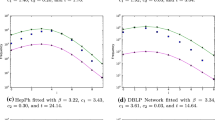Abstract
The aim of this paper is to present an SDP-based algorithm for finding a sparse induced subgraph of order Θ(n) hidden in a semi-random graph of order n. As an application we obtain an algorithm that requires only O(n) random edges in order to k-color a semirandom k-colorable graph within polynomial expected time, thereby extending the results of Feige and Kilian [7] and of Subramanian [15].
Research supported by the Deutsche Forschungsgemeinschaft (grant DFG FOR 413/1-1)
Access this chapter
Tax calculation will be finalised at checkout
Purchases are for personal use only
Preview
Unable to display preview. Download preview PDF.
Similar content being viewed by others
References
Alon, N., Kahale, N.: Approximating the independence number via the ϑ-function. Math. Programming 80 (1998) 253–264.
Alon, N., Kahale, N.: A spectral technique for coloring random 3-colorable graphs. SIAM J. Comput. 26 (1997) 1733–1748
Blum, A., Spencer, J.: Coloring random and semirandom k-colorable graphs. J. of Algorithms 19(2) (1995) 203–234
Coja-Oghlan, A.: On NP-hard semi-random graph problems. Technical report 148, Fachbereich Mathematik der Universität Hamburg (2002)
Coja-Oghlan, A.: Zum Färben k-färbbarer semizufälliger Graphen in erwarteter Polynomzeit mittels Semidefiniter Programmierung. Technical report 141, Fachbereich Mathematik der Universität Hamburg (2002); an extended abstract version is to appear in Proc. 27th. Int. Symp. on Math. Found. of Comp. Sci. (2002)
Feige, U., Kilian, J.: Zero knowledge and the chromatic number, J. Comput. System Sci. 57 (1998), 187–199
Feige, U., Kilian, J.: Heuristics for semirandom graph problems. J. Comput. and System Sci. 63 (2001) 639–671
Feige, U., Krauthgamer, J.: Finding and certifying a large hidden clique in a semi-random graph. Random Structures & Algorithms 16 (2000) 195–208
Hℴastad, J.: Clique is hard to approximate within n 1—ɛ. Proc. 37th Annual Symp. on Foundations of Computer Science (1996) 627–636
Karger, D., Motwani, R., Sudan, M.: Approximate graph coloring by semidefinite programming. J. Assoc. Comput. Mach. 45 (1998) 246–265
Khanna, S., Linial, N., Safra, S.: On the hardness of approximating the chromatic number. Combinatorica 20 (2000) 393–415
Lawler, E.L.: A note on the complexity of the chromatic number problem. Information Processing Letters 5 (1976) 66–67
Mahajan, S., Ramesh, H.: Derandomizing semidefinite programming based approximation algorithms. Proc. 36th IEEE Symp. on Foundations of Computer Science (1995) 162–169
Prömel, H. J., Steger, A.: Coloring K l+1-free graphs in linear expected time. Random Structures & Algorithms 3 (1992) 374–402
Subramanian, C.: Minimum coloring random and semirandom graphs in polynomial average time. J. of Algorithms 33 (1999) 112–123
Author information
Authors and Affiliations
Editor information
Editors and Affiliations
Rights and permissions
Copyright information
© 2002 Springer-Verlag Berlin Heidelberg
About this paper
Cite this paper
Coja-Oghlan, A. (2002). Finding Sparse Induced Subgraphs of Semirandom Graphs. In: Rolim, J.D.P., Vadhan, S. (eds) Randomization and Approximation Techniques in Computer Science. RANDOM 2002. Lecture Notes in Computer Science, vol 2483. Springer, Berlin, Heidelberg. https://doi.org/10.1007/3-540-45726-7_12
Download citation
DOI: https://doi.org/10.1007/3-540-45726-7_12
Published:
Publisher Name: Springer, Berlin, Heidelberg
Print ISBN: 978-3-540-44147-2
Online ISBN: 978-3-540-45726-8
eBook Packages: Springer Book Archive




